
Orangeville is a village in Stephenson County, Illinois. The town's sign lists the population at 800 as of January 2021. The population in 2020 was 738. The population according to the 2010 census was 793, up from 751 in 2000. Using the 2020 population of 738 Orangeville is the 741st largest city in Illinois and the 11,650th largest city in the United States. Orangeville is currently declining at a rate of -0.94% annually and its population has decreased by -6.94% since the 2010 census. The area's earliest white settlers arrived in the year 1833, and the village was platted in 1851 by John Bower, who is considered the village founder. In 1867 Orangeville was incorporated as a village. The town's central business district contains several 19th century commercial buildings, many of which were built during the railroad boom of 1888–1914. By the time the Great Depression was ongoing, business in Orangeville had started to decline, with the last bank closing in 1932. In 1956 another bank started operating in the village and is still in town today. Some recent infrastructure jumps have restored some of the village's old decor.

Plainfield is a village in Will and Kendall counties, Illinois, United States. The population was 39,581 at the 2010 census and an estimated 44,308 in 2019.

Plainfield is a town in Guilford, Liberty, and Washington townships, Hendricks County, Indiana, United States. The population was 27,631 at the 2010 census, and in 2019 the estimated population was 35,287.

Fanwood is a New Jersey Transit railroad station on the Raritan Valley Line, in Fanwood, Union County, New Jersey, United States. The building on the north side of the tracks is a Victorian building and, like the north building at Westfield, is used by a non-profit organization. The address is Fanwood Station, 238 North Avenue, Fanwood, Union County, New Jersey. The ticket office is in the station building on the south side of the tracks. The station was added to the National Register of Historic Places on July 17, 1980.

U.S. Route 66 was a United States Numbered Highway in Illinois that connected St. Louis, Missouri, and Chicago, Illinois. The historic Route 66, the Mother Road or Main Street of America, took long distance automobile travelers from Chicago to Southern California. The highway had previously been Illinois Route 4 (IL 4) and the road has now been largely replaced with Interstate 55 (I-55). Parts of the road still carry traffic and six separate portions of the roadbed have been listed on the National Register of Historic Places.
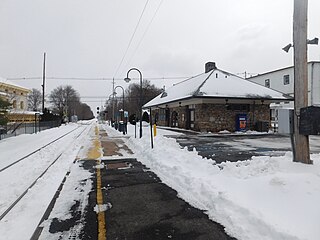
White House is a NJ Transit railroad station on the Raritan Valley Line, in the Whitehouse Station section of Readington in Hunterdon County, New Jersey. The station is on the west side of Main Street in the center and the station building has subsequently been turned into a branch library for the Hunterdon County Library system. This station has no weekend service.

The Sylvanus Wade House is a former stagecoach inn located in Greenbush, Wisconsin, United States. The house provided lodging and meals to travelers in the mid-1800s, before the construction of a nearby railroad made the stagecoach route obsolete. Today, it is part of the Wade House Historic Site.
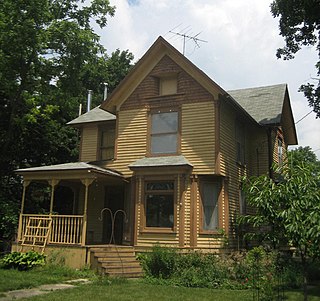
The Stephen Wright House is a home located in the Lee County, Illinois, United States, village of Paw Paw. The Queen Anne style home was constructed sometime between 1895 and 1906 by Paw Paw real estate speculator Stephen Wright. Located along a former Native American trail and stagecoach line, the home is in an area of very similar Queen Anne style homes which may have also been built by Wright. Wright had left the property by 1906 and sold the property to another Paw Paw resident who stayed in the house until his death. The Stephen Wright House was listed on the U.S. National Register of Historic Places on May 22, 2005.

Rancho Los Encinos was a Spanish grazing concession, and later Mexican land granted cattle and sheep rancho and travelers way-station on the El Camino Real in the San Fernando Valley, in present-day Encino, Los Angeles County, California. The original 19th-century adobe and limestone structures and natural warm springs are now within the Los Encinos State Historic Park.

The Clover Hill Tavern with its guest house and slave quarters are structures within the Appomattox Court House National Historical Park. They were registered in the National Park Service's database of Official Structures on October 15, 1966.

Grace Church or Grace Episcopal Church is a historic Episcopal Church located at 600 Cleveland Avenue in Plainfield, Union County, New Jersey, United States. It was added to the National Register of Historic Places on May 10, 2002 for its significance in architecture, art, and music from 1892 to 1930.
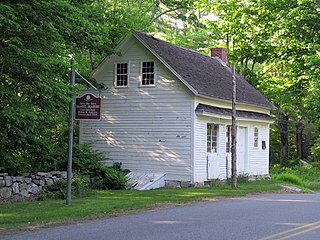
The Gurdon Bill Store is located in Ledyard, Connecticut. In 1818, the land for the store was purchased by Gurdon Bill and his partner, Philip Gray. In 1819, Gray sold his interest in the store for $500. Bill operated the store until his death in 1856 and the store is believed to have made its final transaction in 1868. It has not been used since it was sold to the Congregational Society in 1875, retaining its historical integrity. The store is an 18-by-30-foot by 1+1⁄2-story gable-roofed clapboarded structure built upon fieldstone and stone blocks. It has some unusual architecture in the form of a pent-roof and three-part window shutters. Clouette describes the store as "the best preserved early 19th-century store known in Connecticut." The Gurdon Bill Store was added to the National Register of Historic Places on April 12, 1982.

The Naperville Historic District is a set of 613 buildings in Naperville, Illinois. Of these 613 buildings, 544 contribute to the historical integrity of the area. The district represents the town as it was originally platted and a few early additions.

The Plainfield Halfway House is a historic building in Plainfield, Illinois. Plainfield was first settled in the 1820s by a group seeking to convert the local Pottawatomie to Christianity. Squire L. F. Arnold, the first postmaster of Plainfield, owned the tract of land on which the building stands. In 1834, he built a small building to serve as a post office and a stop for stagecoaches. The property was sold in 1836, and a two-story building was constructed adjacent to the original structure. This new structure operated as a tavern and inn. The inn earned its name by being halfway on the stagecoach line between Chicago and Ottawa. A year later, Dr. Erastus Wight became manager of the establishment, running it until his death in 1845. His son, Dr. Roderick Wight, took over from his father and purchased the building in 1850. He added a one-story addition to the back of the inn later that year.

The former Smith Tavern is located on Bedford Road in the hamlet of Armonk, New York, United States. It is a red frame building dating to the late 18th century, one of the few left in a region that has rapidly suburbanized over the past century. The Smith family, for whom it is named, did not build it but owned it for most of the 19th century.

Laing House of Plainfield Plantation is a historic house in Edison, Middlesex County, New Jersey, United States, built in the early 18th century when the region was being settled by Scottish Quakers in the late 17th and early 18th century, as recalled in the name of The Plainfields and Scotch Plains. The region was part of the colonial era Elizabethtown Tract and later part of Piscataway Township. It is not certain whether the name derives from the plain clothing worn by the founders or is a reference to the landscape. The house was added to the New Jersey Register of Historic Places and the National Register of Historic Places in 1988.
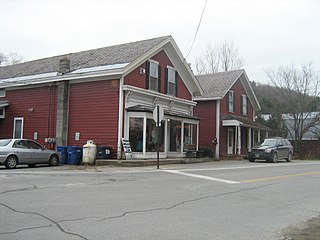
The Charlotte Center Historic District encompasses the historic 19th-century town center of Charlotte, Vermont. Settled c. 1790 and developed mainly in the mid-19th century, the village, stretched along Church Hill Road west of Hinesburg Road, retains a well-preserved 19th-century atmosphere of residential, civic, and commercial buildings. The district was listed on the National Register of Historic Places in 1984.

The Kents Corner Historic District encompasses a well-preserved 19th-century crossroads hamlet in Calais, Vermont. Centered on the junction of Kent Hill Road, Old West Church Road, and Robinson Cemetery Road, it developed as a stagecoach stop with a small industrial presence. It was listed on the National Register of Historic Places in 1973, and substantially enlarged in 2006.
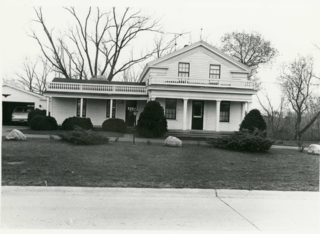
The Daniel O'Sullivan House is a single-family home located at 5035 Flushing Road in Flushing, Michigan. It was listed on the National Register of Historic Places in 1982.

H. Edwards Ficken (1852-1929) was an English American architect in practice in New York City.






















